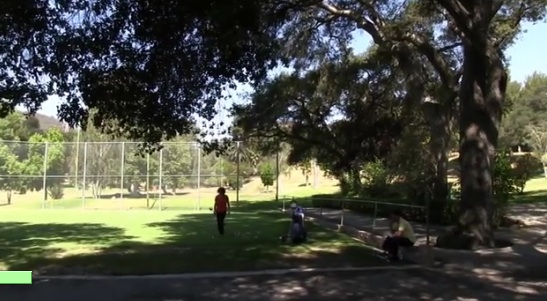June 26th
City Council Unanimously Declares Grove at Tuna Canyon Site a Historic-Cultural Monument Hills
For the origianl arcle, Rafu Shimpo, click here
 An image of the oak grove at the Tuna Canyon site from a video shot by Joe Barrett.
An image of the oak grove at the Tuna Canyon site from a video shot by Joe Barrett.
The Los Angeles City Council on Tuesday unanimously supported an amending motion introduced by Councilmember Richard Alarcon and seconded by Councilmember Mitchell Englander to declare an approximately one-acre oak grove on the location of the former Tuna Canyon Detention Station as a historical-cultural monument.
This location was used as a Department of Justice internment camp for Japanese, German and Italian Americans during World War II. The buildings were later razed to make way for the Verdugo Hills Golf Course. The property is now slated for development into housing.
The city’s Cultural Heritage Commission had recommended against monument status, citing the absence of any structures from the internment era, but Alarcon argued last week that the city has designated many monuments at sites where the original buildings were long gone. He also pointed out that trees — which in this case date back to World War II — have also been designated as historic.
Councilmember Ed Reyes, chair of the Planning and Land Use Management Committee, recommended that discussions be held between the Council District 7 office, the property owner and preservation advocates before the council took action. In a compromise, the councilmembers agreed to designate only the oak grove as a monument, with the exact size of the designated area to be determined.
“The Tuna Canyon Detention Station is an important piece of our history in the northeast San Fernando Valley and a reminder of some of our darkest times as a community, nation and world,” Alarcon said Tuesday. “Declaring the Tuna Canyon Detention Station as a historic-cultural monument allows us to protect this important piece of our history, and give us the opportunity to continue to learn from our past mistakes and preserve this lesson for generations to come. I thank the City Council for their support of my motion and the community for their strong activism to support this designation.”
The City Council approved several actions, including the declaration of “the portion of the property located at 6433 W. La Tuna Canyon Road … with coast live oaks and sycamores [as] a historic-cultural monument.”
The council also adopted the committee’s findings regarding the historical significance of the location and instructed the Department of Planning to convene the Historic Tuna Canyon Detention Station Working Group, to be chaired by Alarcon’s successor, former Assemblymember Felipe Fuentes, and consisting of the property owner (Snowball West Investments) and representative, experts or historians from the Japanese American community, and community stakeholders.
The group is tasked with exploring appropriate ways to commemorate the historical and cultural significance of the site and strategies to secure resources for display/signage, with a request to present findings and recommendations to the council within 60 days.
In addition to Alarcon, Englander and Reyes, present at Tuesday’s council meeting were Councilmembers Herb Wesson, Tom LaBonge, Paul Koretz, Paul Krekorian, Bernard Parks, Bill Rosendahl and Dennis Zine. Absent were Eric Garcetti, Joe Buscaino, Jose Huizar and Jan Perry.
Fred Gaines, attorney for the developer, told the council that while he still had a problem with the motion, he appreciated the council’s efforts to take his concerns into consideration and thanked Reyes for his “thoughtful” leadership. Gaines had argued that while it is important to commemorate the site, formal monument status would impose restrictions that would interfere with the development project.
Lloyd Hitt, past president of the Little Landers Historical Society and a Sunland-Tujunga resident since 1946, said, “I absolutely support Councilmember Alarcon’s effort to protect the site of the Tuna Canyon Detention Station as a historic monument. The historic significance of this site cannot be overstated, and preserving the area would be a positive statement that reflects both our community and the families of those whose fathers passed through the Tuna Canyon Detention Station.”
Nancy Oda, president of the San Fernando Valley Japanese American Community Center, commented, “It will be the only such site close to a large urban city … At this point, we are still working with the developer to clarify our holdings. We are pleased as punch to have reached this huge plateau on our way to the mountaintop.”
The commission and committee received oral and written statements from members of the Japanese American community, including individuals whose family members were held at Tuna Canyon.
The historical significance of the site came to light with a recent release of documents from the National Archives and Records Administration’s Laguna Niguel center, which revealed that there were two detention centers in Los Angeles following the attack on Pearl Harbor. The Immigration and Naturalization Service took over a Civilian Conservation Corps camp and transformed it into the Tuna Canyon Detention Station – a barbed-wire enclosure with lights and armed troops to receive individuals considered “enemy aliens” who had been taken into custody by the FBI on Dec. 16, 1941. The other site was in Griffith Park.
Tuna Canyon operated as a gateway to internment for civilians of Japanese, Italian and German descent as well as some Japanese Peruvians. From its opening until May 1942, 1,490 Issei men passed through the camp and were transferred to other camps in Fort Missoula, Mont., Fort Lincoln, N.D., and Santa Fe, N.M.
Tuna Canyon, which included seven barracks, an infirmary, a mess hall, and office buildings, could hold up to 300 people at once and processed more than 2,500 individuals in total.

